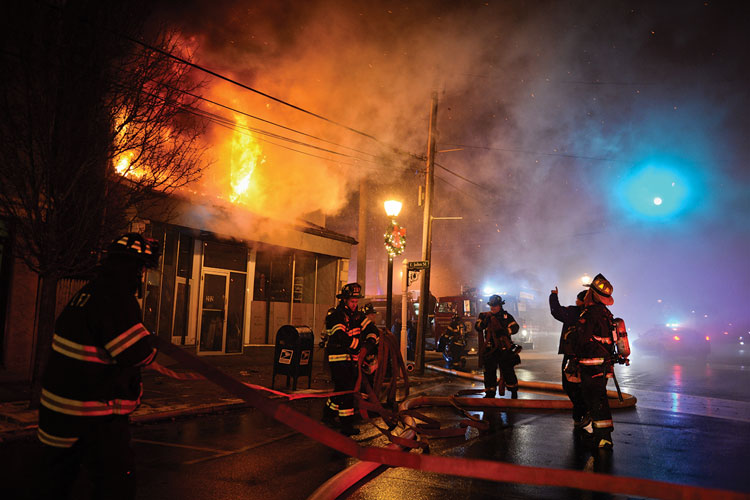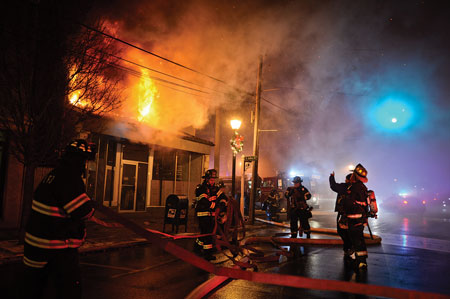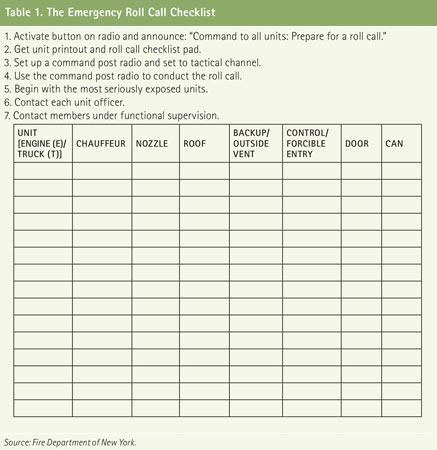
By FRANK LEEB
Safety on the fireground is a paramount concern for all firefighters and fire officers. Regardless of the size of your department or of the fire you encounter, fire conditions can change rapidly, necessitating a change in tactics and a roll call to account for on-scene firefighters.
Situations such as a switch from an interior to an exterior or a defensive operation, a collapse of part or all of a structure, or a loss of water that endangers firefighters not only require transmitting a Mayday or Urgent message; they also should trigger a roll call of all members on scene.
Firefighter accountability is one of the primary responsibilities of all incident commanders (ICs). Written procedures that detail how firefighters and fire officers operate during an emergency roll call should be part of every fire department’s set of written operating procedures.
Having written procedures for an emergency roll call and training on them can greatly influence the outcome when an emergency roll call is needed. Handling an emergency roll call while simultaneously managing other incident aspects is difficult for the IC. Situations that mandate an emergency roll call are often chaotic and rapidly evolving, often with members operating in extremely dangerous positions when the fire or emergency is not yet fully confined, defined, or controlled by operating units.
For these reasons and to increase operational fireground safety, fire departments must have written emergency roll call procedures in place and ensure that all firefighters are familiar with them. Although conducting roll calls is difficult and time-consuming, it is a necessary accountability tool that enhances member safety.
 |
| (1) Firefighters prepare to battle a fire on the second floor of a two-story commercial structure. Early in the operation, fewer firefighters are on scene but more will arrive, increasing the complexity of an emergency roll call if needed. (Photos by Steve Pfost.) |
A roll call must be completed quickly and accurately. At large fires requiring multiple alarms, more on-scene firefighters and units arrive and greatly increase the roll call’s complexity, as do fires in high-rise structures and in subways or fire/emergency scenes covering a wide area (photos 1-2).
Every firefighter and fire officer is responsible for knowing the emergency roll call procedure so everyone can do his part in assisting the officer when a roll call is necessary. Even if only a few members lack knowledge of the procedure, they can slow the entire roll call and lose precious seconds that may be needed to find and rescue a missing firefighter. Proficiency in roll call procedures ensures speed and accuracy, increasing fireground safety for all.
Depending on the situation, the IC may be managing many tasks simultaneously; it is often impractical for the IC to conduct the emergency roll call. This function can be delegated to another chief or company officer or to an experienced firefighter when a chief or company officer is unavailable. To alleviate confusion, the member designated to perform the roll call should be assigned the radio designation of “Roll Call Officer” (RCO) until the completion of the roll call.
To begin an emergency roll call, the IC must authoritatively and forcefully gain control of the radio frequency to ensure everyone understands that a roll call is about to begin. This will also help maintain radio discipline during this chaotic time. Once control of the radio frequency is achieved, the roll call can begin.
Answering the Roll Call
When an emergency roll call has been announced, it is imperative that all members maintain strict radio discipline. During the roll call, members should not transmit unless the RCO calls them to transmit a Mayday or Urgent message, critical information affecting the Mayday or Urgent message, or critical information regarding the ongoing operation.
The RCO will announce that all units must prepare for an emergency roll call. At this point, company officers should attempt to account for their members within sight or hearing without using the radio. When the RCO calls, the company officers should state the number of firefighters who responded on their apparatus and account only for the members they contacted.
Example. “RCO to Engine 1: Account for your members.”
“Engine 1 to RCO: Engine 1 has three firefighters; all firefighters accounted for.”
When answering the roll call, the company officers must state specifically which members they have accounted for. The RCO will then contact the other members of the company.
 |
| (2) After transitioning from an interior to an exterior attack, you must conduct a roll call. More firefighters will be on scene when requesting mutual aid or striking additional alarms. Although accounting for these firefighters using a roll call may be difficult and time-consuming, it must continue to be the IC’s top priority. |
During an emergency roll call, all members must use the same terminology; this will reduce radio traffic and the possibility of miscommunication.
When a firefighter is answering an emergency roll call using the radio, that member will give his company number, his firefighting assignment, and his location.
Example. “RCO to Ladder 2 Roof: What is your location?”
“Ladder 2 Roof to RCO: I’m on the roof of the fire building.”
On hearing that a roll call is about to commence, firefighters should realize that their officer will be attempting to locate and account for his members. For companies standing by or operating outside the building, firefighters can facilitate this process by ensuring they quickly make their officer aware of their location.
For example, consider an engine company that is standing by outside the building with a dry hoseline while the engine company chauffeur is assisting another engine company chauffeur. The assisting chauffeur can quickly seek out and contact his officer using a hand gesture or eye contact to ensure that the officer has accounted for him.
In this scenario, by using a gesture to communicate with his officer, the chauffeur reduces the radio traffic needed to account for that company since the RCO would not need to contact the chauffeur individually via radio. Additionally, when it is not possible for the officer to account for a member, that member must be aware that the RCO will be attempting to contact him for a location. A timely reply when called will greatly reduce the time required to conduct the roll call.
The RCO
The member designated to perform the roll call must be assisted by another member, who will monitor the radio frequency on which the roll call is being conducted and record the members’ positions as they are accounted for. Developing a preprinted roll call form to help keep track of companies will be a great asset during the roll call (Table 1).
The RCO and his assistant should be positioned in an area that is away from the command post but close enough to hear radio transmissions. The area selected should be free of smoke and excess background noise (e.g., apparatus engines, power saws, and railroads).
Additionally, if weather is an issue, the roll call member and the assistant may seek shelter in the apparatus cab, a chief’s vehicle, or another appropriate location.
The RCO conducting the emergency roll call must listen to the radio prior to transmitting to ensure that he is not interfering with emergency transmissions. The members conducting the roll call should begin by making the following statement: “RCO to all units: Prepare for an emergency roll call.”
The RCO will then pause to give officers a chance to account for members so they can accurately reply when called. Determining the order in which to contact companies during the roll call will be incident driven regardless of the order in which companies arrived or were assigned. Companies that were operating in an area from which a Mayday was transmitted for a collapse would logically be contacted first, whereas companies that were not assigned and were outside the structure would likely be a lower priority. Similarly, an Urgent transmitted for a water loss might require the RCO to begin with companies operating on the fire floor or the floor above the water loss.

Since firefighter numbers can fluctuate depending on staffing, all company officers should respond to the RCO by stating the number of firefighters with whom they responded and account only for their members who are within sight or hearing without using the radio. After receiving a reply from the company officer, the RCO will then call the remaining unaccounted-for members of that company.
When the RCO calls, engine companies should respond according to their corresponding positions (i.e., engine positions) whereas ladder companies should answer a roll call according to members’ ladder company assignment. It is important that the RCO remember to account for all chief officers and other fire department personnel who may be on scene.
The member assisting the RCO using the preprinted form or a pad and pen must record the results of the roll call, accounting for members as they respond. When all members of a company have been accounted for, the RCO will notify the company officer. Example: “All members of Ladder 136 are accounted for.” The RCO will then go on to the next company.
If a company officer does not answer when called, the RCO will call a firefighter operating with that officer or another company operating in the immediate area of that officer to locate him. If these members are unable to account for the officer and the officer still has not responded to the roll call, the RCO must notify the IC, who must take the required actions for a missing member. The RCO must then continue the emergency roll call if there are additional missing firefighters. When the roll call is completed, the RCO should announce over the roll call frequency, “RCO to all units: The emergency roll call is completed.”
Often required during the most critical fireground moments, the emergency roll call was developed to quickly and accurately account for all members. A complete roll call on the fireground will ensure the safety of your firefighters and validate the effectiveness of your department’s continual training on emergency roll call tactics and procedures.
FRANK LEEB is a 24-year veteran of and a battalion chief for the Fire Department of New York (FDNY) assigned to Battalion 46. His prior FDNY assignments include Engine 323 and Squad 270 as a firefighter, Engine 324 as a lieutenant, and Engine 76 as a captain. Leeb is also a 32-year member of the East Farmingdale (NY) Volunteer Fire Department. He has a master’s degree in homeland security studies from the Naval Postgraduate School and a degree in fire service administration. Leeb has also completed the FDNY’s Fire Officer Advanced Leadership program and the FDNY/USMA at West Point Combating Terrorism program.
25 WAYS FOR OFFICERS TO IMPROVE COMPANY SAFETY
Fire Training Drill: The Survival Essentials – PAR
Do You Have PAR?
Fire Engineering Archives

